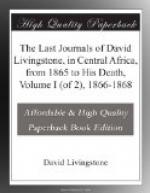We came close to the foot of several squarish mountains, having perpendicular sides. One, called “Ulazo pa Malungo,” is used by the people, whose villages cluster round its base as a storehouse for grain. Large granaries stand on its top, containing food to be used in case of war. A large cow is kept up there, which is supposed capable of knowing and letting the owners know when war is coming.[30] There is a path up, but it was not visible to us. The people are all Kanthunda, or climbers, not Maravi. Kimsusa said that he was the only Maravi chief, but this I took to be an ebullition of beer bragging: the natives up here, however, confirm this, and assert that they are not Maravi, who are known by having markings down the side of the face.
We spent the night at a Kanthunda village on the western side of a mountain called Phunze (the h being an aspirate only). Many villages are planted round its base, but in front, that is, westwards, we have plains, and there the villages are as numerous: mostly they are within half a mile of each other, and few are a mile from other hamlets. Each village has a clump of trees around it: this is partly for shade and partly for privacy from motives of decency. The heat of the sun causes the effluvia to exhale quickly, so they are seldom offensive. The rest of the country, where not cultivated, is covered with grass, the seed-stalks about knee deep. It is gently undulating, lying in low waves, stretching N.E. and S.W. The space between each wave is usually occupied by a boggy spot or watercourse, which in some cases is filled with pools with trickling rills between. All the people are engaged at present in making mounds six or eight feet square, and from two to three feet high. The sods in places not before hoed are separated from the soil beneath and collected into flattened heaps, the grass undermost; when dried, fire is applied and slow combustion goes on, most of the products of the burning being retained in the ground, much of the soil is incinerated. The final preparation is effected by the men digging up the subsoil round the mound, passing each hoeful into the left hand, where it pulverizes, and is then thrown on to the heap. It is thus virgin soil on the top of the ashes and burned ground of the original heap, very clear of weeds. At present many mounds have beans and maize about four inches high. Holes, a foot in diameter and a few inches deep, are made irregularly over the surface of the mound, and about eight or ten grains put into each: these are watered by hand and calabash, and kept growing till the rains set in, when a very early crop is secured.
13th October, 1866.—After leaving Phunze, we crossed the Levinge, a rivulet which flows northwards, and then into Lake Nyassa; the lines of gentle undulation tend in that direction. Some hills appear on the plains, but after the mountains which we have left behind they are mere mounds. We are over 3000 feet above the sea, and the air is delicious; but we often pass spots covered with a plant which grows in marshy places, and its heavy smell always puts me in mind that at other seasons this may not be so pleasant a residence. The fact of even maize being planted on mounds where the ground is naturally quite dry, tells a tale of abundant humidity of climate.




